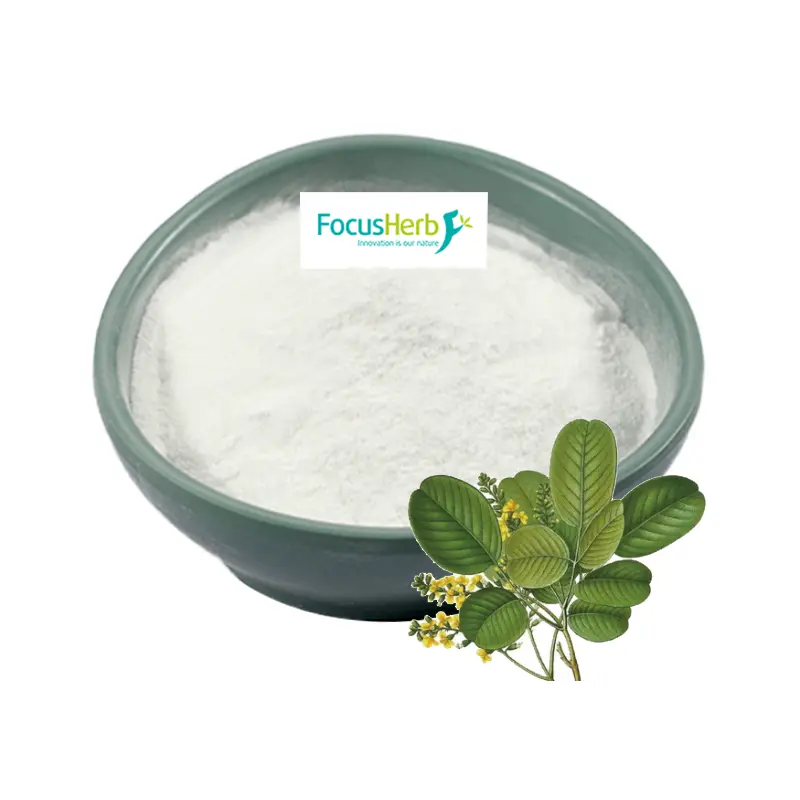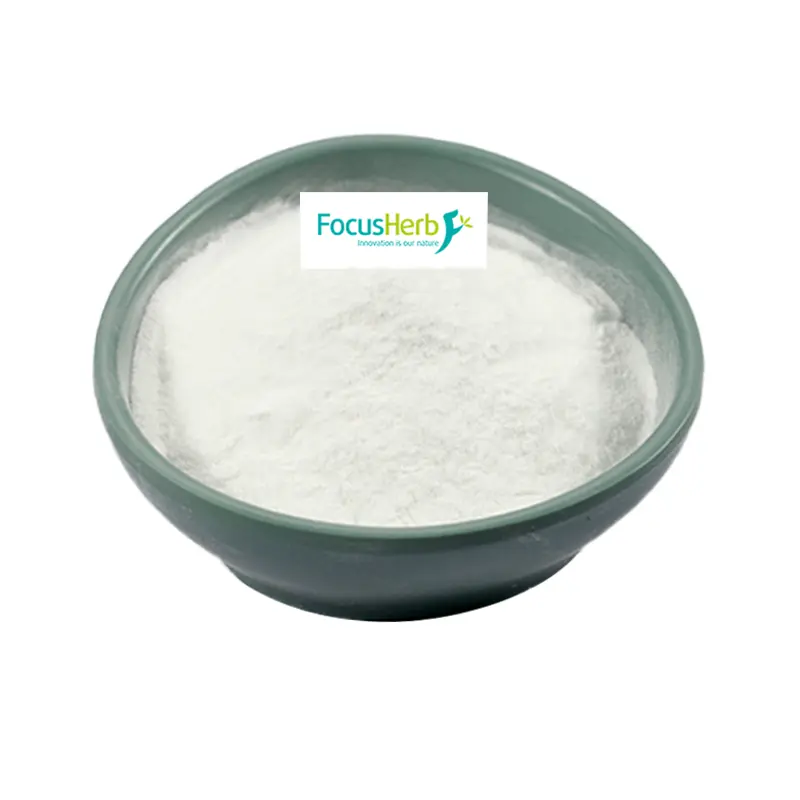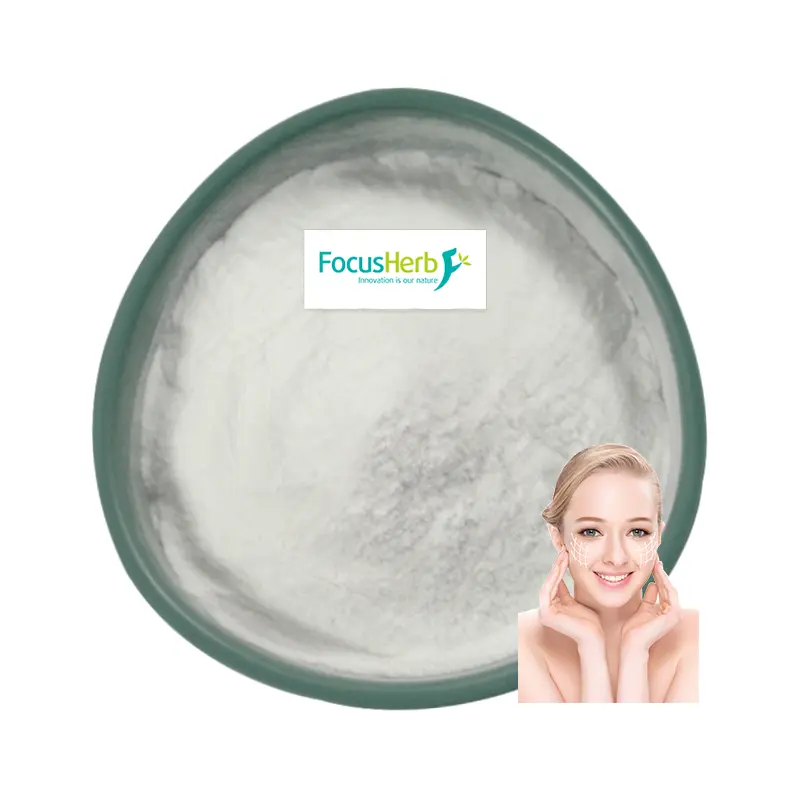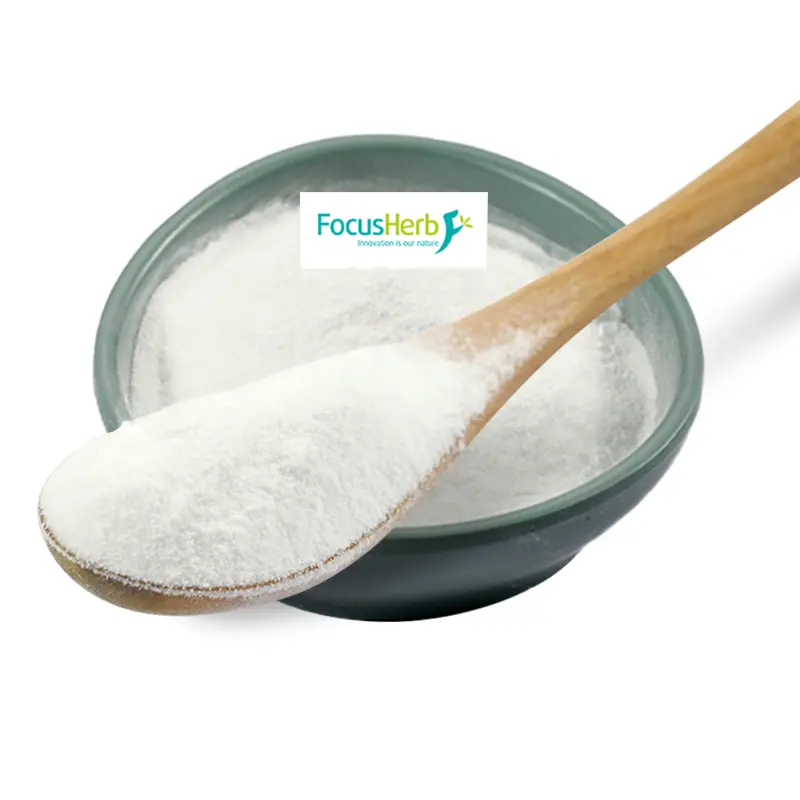Pterostibene is a natural polyphenolic compound with a pyrogallol structure. Chemically, it is a methylated derivative of resveratrol. Don’t underestimate this small structural change; it significantly improves Pterostibene’s performance. Its oral bioavailability is astonishing, reaching 80%, four times that of resveratrol. This means that after ingestion, Pterostibene is more efficiently absorbed and utilized by the body, allowing it to fully function.
Pterostibene is widely distributed and can be found in plants such as blueberries, grapes, and rosewood. Its name is also quite historical, as it was first successfully isolated from a plant in the genus Pterostibene. Its diverse properties, including being a phytoestrogen and possessing potent antioxidant capacity, have made Pterostibene a focus of research in functional foods and pharmaceuticals in recent years, attracting numerous researchers to delve deeper into its secrets. Just like in blueberries, Pterostibene, as a key antioxidant, protects the fruit from oxidative damage while also providing health benefits to those who consume it.
 Core Chemical Properties and Basis of Action
Core Chemical Properties and Basis of Action
The molecular structure of Pterostibene resembles a meticulously designed precision instrument, with the dimethoxy substituents playing a crucial role. Their presence imparts Pterostibene with enhanced lipid solubility. This property makes Pterostibene a “master key,” allowing it to easily penetrate cell membranes and enter the cell interior. Once inside, its “target” is clear: directly acting on estrogen receptors (ERα/ERβ) in the cell nucleus. By specifically binding to these receptors, it participates in the intracellular estrogen regulation process, playing a role in maintaining endocrine homeostasis.
In addition to acting on estrogen receptors, Pterostibene also influences multiple key signaling pathways within the cell, including AMPK and NF-κB. When Pterostibene acts on the AMPK signaling pathway, it activates related protein kinases, thereby regulating cellular energy metabolism, enabling cells to utilize energy more efficiently and maintain normal physiological function. In response to inflammatory responses, Pterostibene effectively exerts its anti-inflammatory effects by inhibiting the activation of the NF-κB signaling pathway, reducing the expression of inflammation-related genes and the release of inflammatory factors. At a molecular level, these regulatory processes ultimately stem from Pterostibene’s influence on gene expression. Like a “gene commander,” it precisely regulates gene expression levels according to the body’s needs, thereby achieving multiple physiological functions such as anti-inflammatory, antioxidant, and metabolic regulation, providing a strong defense against human health and laying the molecular foundation for its application in multi-target health interventions.
Core Benefits: Molecular Mechanisms of Multi-System Health Intervention
(I) Antioxidant and Anti-Inflammatory: A Cellular Defense System for Aging
In the human body, oxidative stress and inflammatory responses act like a pair of “hidden killers,” constantly threatening cellular health and closely linked to aging and the development of numerous chronic diseases. Pterostibene, like a valiant “guardian,” demonstrates remarkable antioxidant and anti-inflammatory capabilities.
From an antioxidant perspective, Pterostibene’s mechanism of action is ingenious. It acts as a “metal ion catcher,” effectively chelating metal ions and reducing free radical production at the source. Because metal ions often act as catalysts in the body, promoting free radical production, Pterostibene’s chelation of metal ions acts like a “source of free radical production.” It also activates antioxidant enzymes such as SOD and GSH-Px. These antioxidant enzymes act like “cleaning guards” within cells. SOD converts superoxide anions (O₂⁻) into hydrogen peroxide, while GSH-Px further reduces hydrogen peroxide to water. These enzymes effectively scavenge superoxide anions (O₂⁻), hydroxyl radicals (・OH), and other free radicals within cells, inhibiting lipid peroxidation. Studies have shown that Pterostibene has a very potent antioxidant activity, over 10 times greater than that of vitamin C. During the preservation of blueberries, Pterostibene effectively inhibits lipid peroxidation, keeping the berries fresher longer and providing a delicious and healthy experience.
Pterostibene also excels in regulating inflammatory pathways. It can precisely target and inhibit the NF-κB signaling pathway. The NF-κB signaling pathway plays a key regulatory role in inflammatory responses. When activated, it triggers the release of a series of pro-inflammatory cytokines, such as IL-6 and TNF-α. Pterostibene acts like a “lock” on the NF-κB signaling pathway, preventing its activation and thereby reducing the release of pro-inflammatory cytokines. For example, in osteoarthritis models, articular cartilage is invaded by inflammation, leading to increased expression of the enzyme MMP-13, accelerating cartilage degeneration. However, intervention with Pterostibene reduced MMP-13 expression in articular cartilage by 60%, significantly slowing the progression of cartilage degeneration and offering hope for osteoarthritis patients.
(II) Cardiovascular Protection: Bidirectional Regulation of Vascular Rejuvenation
Cardiovascular disease has become the leading global threat to human health, and the potential demonstrated by Pterostibene in cardiovascular protection offers new hope for its prevention and treatment.
Endothelial function is crucial for maintaining the normal functioning of the cardiovascular system, and Pterostibene plays a unique role in optimizing endothelial function. It promotes the activity of nitric oxide synthase (eNOS). NO acts as a vasodilator, relaxing vascular smooth muscle, thereby dilating blood vessels and improving microcirculation. Pterostibene can also reduce oxidative stress-induced endothelial damage. Studies on vascular protection in hyperhomocysteinemia have shown that Pterostibene protects endothelial cells from damage by regulating the Nrf2-mediated AMPK/STAT3 pathway or activating the PI3K/Akt signaling pathway to mediate endothelial nitric oxide synthase (eNOS) phosphorylation, thereby reducing the risk of atherosclerotic plaque formation by 37%, significantly lowering the risk of cardiovascular disease.
Abnormal lipid metabolism is a major risk factor for cardiovascular disease, and Pterostibene has excellent regulatory capabilities in this regard. Acting as a “lipid metabolism commander,” it activates PPARγ receptors, promotes adipocyte differentiation, and enables adipocytes to more efficiently store and metabolize fat. It also inhibits the activity of hepatic cholesterol synthase (HMG-CoA reductase), reducing cholesterol synthesis. In a clinical study, supplementing with 200mg of Pterostibene daily for eight weeks surprisingly reduced LDL-C (low-density lipoprotein cholesterol, commonly known as “bad cholesterol”) levels by 12% and increased HDL-C (high-density lipoprotein cholesterol, commonly known as “good cholesterol”) by 9%. These results demonstrate that Pterostibene can effectively regulate blood lipids and reduce the risk of cardiovascular disease.
(III) Endocrine Regulation: Precise Adaptation of Estrogen Balance
The endocrine system, like the body’s “regulatory center,” plays a key role in maintaining normal physiological functions, and estrogen plays an indispensable role. Pterostibene, a selective estrogen receptor modulator (SERM), can precisely regulate estrogen levels, maintaining health in multiple aspects of the body.
For women, bone health is a particular concern as they age, and Pterostibene plays an outstanding role in maintaining bone health. It promotes osteoblast differentiation, acting as a “vitalizer” for osteoblasts, enabling them to more actively synthesize bone matrix and promote bone formation. It also inhibits osteoclast activity and reduces bone resorption. In postmenopausal women, declining estrogen levels accelerate bone loss, making them prone to osteoporosis. Encouragingly, six months of Pterostibene supplementation showed a 21% increase in osteocalcin levels and a 1.8% increase in lumbar spine bone density. This demonstrates the positive impact of Pterostibene on bone health in postmenopausal women, helping to prevent and improve osteoporosis.
Pterostibene also has a significant impact on metabolic syndrome. By mimicking the effects of estrogen, it modulates insulin sensitivity, enabling cells to better respond to insulin and more efficiently absorb and utilize glucose. It also reduces visceral fat accumulation, mitigating the adverse effects of obesity on metabolism. In people with prediabetes, Pterostibene supplementation reduced fasting blood sugar and insulin resistance by 9% and 15%, respectively. This offers a new intervention for preventing diabetes and improving the health of those with metabolic syndrome. (IV) Anti-tumor Potential: A New Target for Multi-Stage Cancer Intervention
Cancer, a dreaded disease, has always been a key target for medical research. In recent years, the demonstrated anti-tumor potential of Pterostibene has given researchers and patients new hope, potentially opening new avenues for cancer prevention and treatment.
During tumor cell proliferation, Pterostibene acts as a “proliferation brake,” effectively arresting the cell cycle at the G0/G1 phase. The cell cycle is like a “clock” for cell growth and division. When arrested in the G0/G1 phase, cells are unable to enter the DNA synthesis and division phases, thereby inhibiting tumor cell proliferation. Pterostibene also downregulates the expression of proliferation proteins such as Cyclin D1. These proliferation proteins play a key role in cell proliferation, and their downregulation by Pterostibene further weakens the proliferation of tumor cells. Studies have found that Pterostibene exhibits IC50 values as low as 5-10μM against prostate and breast cancer cell lines, meaning that even at relatively low concentrations, Pterostibene can significantly inhibit tumor cell proliferation.
In addition to inhibiting tumor cell proliferation, Pterostibene also has a unique role in regulating the activation of dormant cancer cells. During cancer treatment, dormant cancer cells are often the culprits for tumor recurrence, acting like time bombs hidden within the body, poised to activate and trigger tumor recurrence at any moment. Pterostibene can induce apoptosis in dormant prostate cancer cells by upregulating SOD2, effectively issuing a “death warrant” to dormant cells, effectively extinguishing their hiding place. In animal studies, Pterostibene treatment reduced tumor volume by 42% with no significant side effects. This result undoubtedly offers new insights into cancer treatment and is expected to play a significant role in future clinical trials, offering greater hope for survival for cancer patients.
Application Scenarios: From Traditional Medicine to Modern Precision Intervention
(I) Classic Applications Guided by Traditional Chinese Medicine Theory
Within the trove of Traditional Chinese Medicine theory, Pterostibene possesses unique application value. Its heart-nourishing and calming effects, as well as its antibacterial and anti-inflammatory properties, have brought health benefits to numerous patients.
In terms of heart-nourishing and calming the mind, Pterostibene can be described as a “soothing agent” for the soul. In modern society, the fast-paced pace of life and immense pressure leave many people struggling with anxiety and insomnia. Pterostibene can modulate GABA receptor activity. GABA, a key neurotransmitter, inhibits overexcitation in the nervous system, thereby alleviating anxiety and improving symptoms of insomnia and dreaminess. In clinical practice, Pterostibene is often combined with herbs such as Ziziphus jujuba seed and Polygala tenuifolia. Ziziphus jujuba seed nourishes the heart and liver, calms the mind, and Polygala tenuifolia calms the mind, improves intelligence, and connects the heart and kidneys. These herbs work synergistically with Pterostibene, resulting in significant benefits. Research has shown that this combination can shorten sleep onset latency by 30% and improve sleep efficiency by 25%, allowing patients to fall asleep faster and enjoy better sleep quality, waking refreshed and better equipped to cope with life and work.
Pterostibene also performs exceptionally well in the antibacterial and anti-inflammatory field. It has potent inhibitory effects against common pathogens such as Staphylococcus aureus and Candida albicans, with a minimum inhibitory concentration (MIC) of only 12.5μg/mL. During the peak respiratory infection season, the human respiratory mucosa is vulnerable to bacterial invasion, causing symptoms such as coughing, sputum production, and fever. Pterostibene can be used as an adjunctive treatment for respiratory infections, reducing inflammation and alleviating discomfort. For skin inflammation such as eczema and dermatitis, Pterostibene can inhibit bacterial growth, alleviate redness, swelling, and itching, and promote skin repair. In the treatment of some mild skin inflammations, topical preparations containing Pterostibene can shorten inflammation resolution by 4-5 days, significantly reducing the frequency of antibiotic use and mitigating the problems of drug resistance caused by overuse, thus providing greater safety for patients.
(II) Diversified Practices in Modern Health
With the rapid advancement of modern technology, the applications of Pterostibene in the health field are becoming increasingly diverse, showing great potential in dietary supplements and pharmaceutical research and development.
In the dietary supplement sector, Pterostibene, with its high purity, has attracted widespread consumer attention in single-ingredient formulations. Currently, Pterostibene dietary supplements on the market generally boast a purity of up to 98%, allowing its active ingredients to more fully exert their effects. Generally, the recommended dosage is 50-200mg/day. Within this dosage range, Pterostibene can effectively supplement the body with its antioxidant and anti-inflammatory properties. To further enhance the bioavailability of Pterostibene, researchers have found that combining it with black pepper extract (containing piperine) is a good option. Piperine inhibits Pterostibene metabolism in the intestine, making it more readily absorbed by the body and increasing its bioavailability by 40%. This allows Pterostibene to function better in the body, safeguarding our health.
Pterostibene shows promising prospects in pharmaceutical research and development. A Phase II clinical trial for osteoarthritis has yielded impressive results. When Pterostibene was administered intraperitoneally at a dose of 20 mg/kg, joint pain scores decreased by 52%, significantly alleviating joint pain and improving patients’ quality of life. Pterostibene has also achieved new breakthroughs in the anti-aging field, with the development of anti-aging products in combination with AKG. By activating the PI3K/AKT pathway, this combination modulates cell growth, proliferation, and survival, reducing the subjects’ biological age by an average of eight years. This offers new hope in the pursuit of youth and health, and is expected to provide new treatments for delaying aging and preventing age-related diseases.
Food Sources and Supplements: A Precise Guide to Scientific Intake
(I) Efficient Consumption of Natural Food Sources
Our daily diets contain numerous natural sources rich in Pterostibene. Proper consumption of these foods can supplement our Pterostibene supply and provide health benefits.
Fruits are an important source of Pterostibene. Blueberries are a Pterostibene gold mine, containing approximately 5-10μg per gram. Among many fruits, blueberries are highly sought after for their unique flavor and rich nutritional profile. Whether eaten plain or made into blueberry jam or yogurt, they are a delicious and healthy choice. Grapes, especially the skins of purple grapes, are also a good source of Pterostibene, containing 3-8μg per gram. When consuming grapes, it’s best to eat the skins to fully absorb the Pterostibene. Mulberries also contain Pterostibene, containing 2-5μg per gram. During mulberry season, picking fresh mulberries and savoring their sweet and sour flavor is a great way to supplement Pterostibene. Nutritionists recommend consuming 200-300g of fresh berries daily. This not only satisfies your taste buds but also provides you with ample Pterostibene, allowing you to enjoy delicious food while also benefiting your health.
Traditional Chinese medicine and functional foods are also a way to obtain Pterostibene. Pterostibene is found in rosewood extract, with the standard content of Pterostibene at ≥5%. When using rosewood extract, it’s important to choose products from reputable sources to ensure quality and safety. Avoid harmful effects such as heavy metal residues from unidentified sources. Fermented soy products, such as nattokinase compounds, also contain Pterostibene. These functional foods not only provide Pterostibene, but also offer other health benefits, such as nattokinase helping to dissolve blood clots and promoting cardiovascular health. However, it’s also important to choose products from reputable manufacturers to ensure quality and safety, ensuring they are safe to consume.
(II) Core Principles of Supplement Use
Pterostibene supplements offer a convenient option for those who cannot get enough Pterostibene from their daily diet or have specific health needs. However, their use must adhere to scientific principles to ensure safety and effectiveness.
Suitable populations primarily include middle-aged and elderly individuals seeking anti-aging treatments. With aging, the body’s various functions gradually decline, and the signs of aging become increasingly apparent. Pterostibene’s antioxidant and anti-inflammatory properties can help delay aging, boost immunity, and improve overall health in these individuals. People at high risk of metabolic syndrome are also suitable candidates for Pterostibene supplements. These individuals often suffer from insulin resistance, obesity, and dyslipidemia. Pterostibene can regulate insulin sensitivity, reduce visceral fat accumulation, and regulate blood lipids, potentially playing a positive role in improving metabolic syndrome. Patients with mild inflammatory conditions, such as early-stage rheumatoid arthritis, may also consider Pterostibene supplements. Pterostibene’s anti-inflammatory properties can reduce inflammation, alleviate symptoms, and aid in treatment and recovery.
However, Pterostibene supplements are not suitable for everyone. Pregnant and breastfeeding women should not use Pterostibene supplements. This is because Pterostibene, as a phytoestrogen, may affect estrogen balance, potentially adversely affecting fetal development and the health of breastfeeding women. Regarding drug interactions, caution is advised when using Pterostibene with anticoagulants such as warfarin. A minimum of four hours should be allowed between doses to prevent bleeding. This is because Pterostibene may affect warfarin metabolism, enhancing its anticoagulant effects and potentially increasing the risk of bleeding. Those with spleen and stomach deficiency should also exercise caution when using Pterostibene supplements, as they may experience symptoms such as diarrhea. It is recommended that these individuals start with a low dose of 50mg/day, gradually allowing their body to tolerate the supplement and observing their response. If discomfort develops, the dose should be adjusted or discontinued promptly. Before using Pterostibene supplements, it is best to consult a professional physician or nutritionist for advice. A personalized supplementation plan tailored to your individual medical condition and health needs should be developed to ensure safe and effective use and protect your health.
Frontier Exploration: From Molecular Mechanisms to the Future of the Industry
(I) Breakthrough Discoveries in the Anti-Aging Field
In the pursuit of delaying aging and maintaining youthful vitality, scientists have never ceased their exploration. A series of groundbreaking discoveries involving Pterostibene in the anti-aging field have undoubtedly injected new vitality into this journey.
In 2022, a research team from China Medical University achieved remarkable results. Through in-depth research, they confirmed that Pterostibene has a unique mechanism of action in the anti-aging field, particularly its remarkable performance in inhibiting the senescence-associated secretory phenotype (SASP) of chondrocytes. When Pterostibene is active, it precisely regulates relevant intracellular signaling pathways, reducing the percentage of cells positive for the senescence markers p16 and p21 by 48%-53%. This discovery is of great significance, providing a novel intervention strategy for the prevention and treatment of age-related diseases such as osteoarthritis. Osteoarthritis, a common age-related disease, causes significant pain for patients and severely impacts their quality of life. This effect of Pterostibene offers a window of hope for osteoarthritis patients, potentially helping them alleviate pain, slow disease progression, and resume a normal life. Furthermore, the synergistic effect of Pterostibene and AKG (α-ketoglutarate) demonstrates powerful anti-aging potential. As a key intermediate in the tricarboxylic acid cycle, AKG plays a crucial role in energy metabolism and aging regulation. When Pterostibene and AKG are used together, they synergize to produce a remarkable chemical reaction. Studies have shown that this synergistic effect can improve mitochondrial function by 19%. Mitochondria are known as the “energy factories” of cells, and their enhanced function is crucial for maintaining normal cellular activity. Mitochondrial function gradually declines with age, which is a major factor in aging. The synergistic effect of Pterostibene and AKG effectively enhances mitochondrial function, providing more energy for cells and thus delaying cellular aging. This discovery is a core component of the dual “metabolic-epigenetic” anti-aging pathway. This discovery opens new avenues in the anti-aging field, demonstrating the potential for multi-pathway synergistic anti-aging. It holds the promise of developing more effective anti-aging products in the future, helping people realize their dream of delaying aging.
(II) Industry Development and Market Prospects
As people’s pursuit of health and beauty grows stronger, Pterostibene, with its remarkable efficacy, demonstrates tremendous potential in both industrial development and market prospects, becoming a shining star in the health industry.
In terms of market size, the global Pterostibene market is booming, growing steadily at a compound annual growth rate of 9%. According to relevant forecasts, the market size is expected to reach 50 million yuan by 2029. This growth trend reflects the high market recognition and strong demand for Pterostibene, attracting numerous companies to invest in the research and development and production of Pterostibene-related products.
In terms of technological research and development, two main approaches are currently being developed: natural extraction and chemical synthesis. Natural extraction, which primarily extracts Pterostibene from plants such as blueberries and grape skins, offers the advantages of natural sources and high safety, making it highly popular among consumers. However, the relatively low content of Pterostibene in natural plants and the high extraction cost have limited its large-scale production. To address this issue, chemical synthesis has emerged, with microbial fermentation being a research hotspot. Microbial fermentation offers advantages such as low cost, high yield, and sustainability. Genetically engineering microorganisms enables efficient synthesis of Pterostibene. For example, some research teams have successfully increased the yield and purity of Pterostibene using microorganisms such as Escherichia coli by optimizing fermentation conditions and genetic manipulation, paving the way for large-scale production.
To further enhance the efficacy of Pterostibene, high-purity (≥99%) nanoliposome formulations have become a hot topic in the development of delivery systems. Pterostibene suffers from poor water solubility and a first-pass effect in the intestine, which limits its absorption and utilization in the body. Nanoliposome formulations, like a tailor-made “delivery vehicle” for Pterostibene, effectively address these issues. Nanoliposomes possess excellent biocompatibility and targeted properties, encapsulating Pterostibene, increasing its water solubility and minimizing metabolism and degradation in the intestine, thereby enhancing its bioavailability. Furthermore, nanoliposomes enable precise delivery of Pterostibene, enabling it to more effectively target cells and tissues and exert its therapeutic effects. In terms of market applications, Pterostibene, with its outstanding antioxidant, anti-inflammatory, and anti-aging properties, has found cross-industry applications in cosmeceuticals and functional foods. In the cosmeceuticals sector, anti-wrinkle serums have become a key application for Pterostibene. Pterostibene can promote collagen synthesis, enhance skin elasticity, reduce wrinkles, and make skin firmer and smoother. Many well-known brands have launched anti-wrinkle serums containing Pterostibene, which have been enthusiastically sought after by consumers. In the functional food sector, sustained-release capsules are a common dosage form for Pterostibene. Using sustained-release technology, Pterostibene is slowly released within the body, prolonging its duration and enhancing its efficacy. These Pterostibene sustained-release capsules are suitable for individuals with special health needs, such as the elderly and those who work late at night, providing them with a convenient and effective health supplement. With continuous technological advancements and market expansion, we believe Pterostibene will continue to play a significant role in even more areas in the future, bringing even more exciting benefits to people’s health and beauty.
Pterostibene has evolved from a traditional medicinal plant active ingredient into a multidisciplinary “precision health intervention molecule.” Its value lies not only in improving single diseases but also demonstrates how natural products, through modern scientific deciphering, have made the leap from empirical application to clear mechanisms. In today’s rapidly aging population, rationally understanding the limits of its efficacy and scientifically balancing its intake with individual health needs will maximize the health potential of this natural polyphenol and promote the precise connection between “phytoactive ingredients, human targets, and systemic health.”



















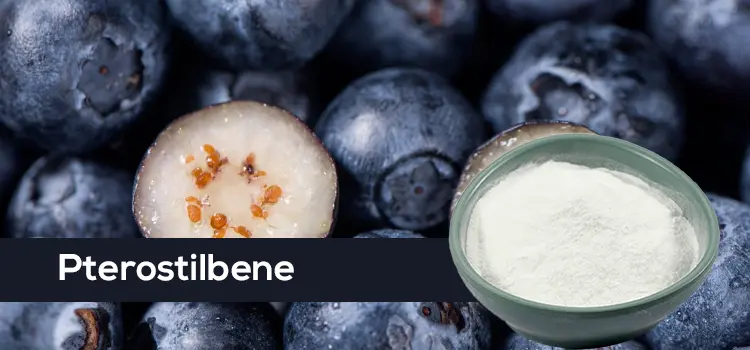 Core Chemical Properties and Basis of Action
Core Chemical Properties and Basis of Action